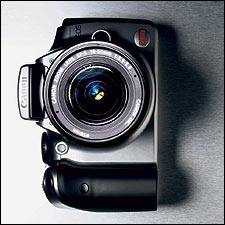OUR STORY THIS MONTH BEGINES where many other cool things do: at the beach. That’s because the lenses inside every cutting-edge camera and razor-sharp binocular presented on the following pages began life as silica, a.k.a. common sand. And while the soul of these rigs may be true grit, today’s sizzle is in the circuitry. Which spells great news for world-beaters and would-be Jeff Corwins. Forget about hustling duffel bags of film around ancient airport X-ray machines—today’s top-shelf SLRs stash tens of thousands of stunning photographs on stamp-size memory cards, while tiny videocams crisply capture every variety of wildlife, including that on your local singletrack. We’ve tested the best of the new chip-enhanced imaging and lensing products—including near-military-grade night vision, and binoculars hardwired for off-road viewing. Go ahead, feast your eyes.
Canon's Digital Rebel
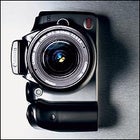 Prize Shooter: Canon’s Digital Rebel offers SLR muscle for less than a grand.
Prize Shooter: Canon’s Digital Rebel offers SLR muscle for less than a grand.The Big Shots
Lean on the shutter: The SLR camera—that classic expedition essential—has joined the megapixel revolution
Top Pro Tell-All
“If you find yourself in a truly epic landscape that you know you will want to turn into a big print—say, the foot of Cerro Torre just as the clouds break—set your digital SLR camera to shoot in “raw” format, not JPEG. Given a raw file, printers can easily adjust levels, color balance, and exposure of specific areas of the frame.”In May, photographer JIMMY CHIN shot stills on top of the world for an upcoming Mount Everest feature film.
Pentax *IST D, Canon EOS Digital Rebel, Olympus E-1, Nikon D70
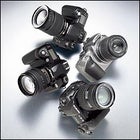 Clockwise from top: Pentax *IST D, Canon EOS Digital Rebel, Olympus E-1, Nikon D70
Clockwise from top: Pentax *IST D, Canon EOS Digital Rebel, Olympus E-1, Nikon D70The smallest digital SLR we could find—at two pounds, including lens—PENTAX’s 6.1-megapixel *IST D is among the featherweights of the genre. But it doesn’t skimp on features: A pop-up flash reduces harsh shadows on sunny outdoor shots, the shutter button is recessed for protection from clumsy campers, and, should your travels take you off the grid, this rechargeable unit also accepts AAs. Big-fingered shutterbugs may find the compact toggle switch that works the LCD menus a bit too small; a keeper shot was accidentally deleted by thumbing yes instead of—bugger all!—no. $1,480, with 16–45mm lens; 800-877-0155,
CANON aimed its EOS DIGITAL REBEL at film buffs who know and love the company’s classic Rebel series—to them, the switches and dials will feel like old friends. Got an existing arsenal of Canon’s old-school SLR lenses? The Digital Rebel will accept ’em all. Plus, a dozen pre-programmed shooting modes (including “sports,” which sets a high shutter speed and adjusts the aperture to match) will appeal to those who hate futzing with f-stops. Eight-by-ten glossies from the 6.3-megapixel Digital Rebel compete with those from film, and focus is stealthy-quiet and quick. $999, with 15–85mm lens; 800-652-2666,
Looking to move up from point-and-shoots? The OLYMPUS E-1 is your graduation present. The body is sexy and solid, with a slip-free grip and controls that are easy to learn and hard to screw up; we left the manual in its shrink wrap and were off and running in two minutes. Its 5.5-megapixel images are in the same league as the other cameras shown here, but what tips the scale is the E-1’s adventure readiness. An included snap-on shield kept even the siltiest dust off the LCD screen, and the lithium-ion battery, also included, still read “full” after two long days of shooting. $1,945, with 14–54mm lens; 888-553-4448,
At $999 (body only), the NIKON D70 is a little pricier than the Canon yet still packs a lot of bang for the buck. For starters, this one-pound-five-ounce, 6.1-megapixel SLR is nearly as light as the Pentax also shown here yet somehow feels more solid. An almost prescient autofocus instantly zeroes in on your quarry, then continuously adjusts to stay locked on to that charging moose until you nail the shot. Buyer’s tip: Drop another $300 for the starter kit, which bundles Nikon’s outstanding all-purpose 18–70mm lens, good for capturing purple mountains’ majesty as well as chasing your honey around the house. Smart ergonomics make this camera feel good in the hand. (Sole exception: the thumb-foiling toggle switch driving the menus.) $1,300, with 18–70mm lens; 800-645-6689,
More to Love…
A tripod shouldn’t tie you down. At a wispy two pounds ten ounces, the carbon-fiber GITZO MOUNTAINEER SPORT ($442; 201-818-9500, ) will immobilize any digital SLR, but it packs down to 18.5 inches for carry-on convenience. » MOUNTAINSMITH designed its sleek gray-and-black PARAGON CAMERA DAYPACK (not pictured, $117; 800-551-5889, ) for candid action; just pluck your SLR from the padded, zippered top compartment and start firing. Clouds looming? Deploy the Paragon’s integrated rain cover.
Rock Steady, Razor Sharp
See in the dark, steady the view, and save the scene forever with this new group of digital binos and scopes
Top Pro Tell-All
“It’s OK to use saliva to clean your binocular lenses while in the field. Just lick ’em and wipe with the tail of your shirt—you can taste when the glass is clean and when it’s gritty. If you ever want to stop conversation on a bus, just take out your binoculars and start licking.”World Series of Birding founder PETE DUNNE recently crisscrossed the country researching a new field guide to North American birds, due out in fall 2005.
Leupold Wind River RB800C, Nikon Stabileyes 16X32, Yukon Optics NVMT 3X42 Sea Wolf, Celestron Vistapix 72212
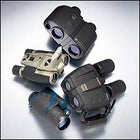 Clockwise from top: Leupold Wind River RB800C, Nikon Stabileyes 16X32, Yukon Optics NVMT 3X42 Sea Wolf, Celestron Vistapix 72212
Clockwise from top: Leupold Wind River RB800C, Nikon Stabileyes 16X32, Yukon Optics NVMT 3X42 Sea Wolf, Celestron Vistapix 72212Eagle Optics Universal Extender 2.5x
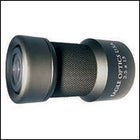
Though they’re designed for hunters, just about anyone will have a blast with the 23-ounce LEUPOLD WIND RIVER RB800C rangefinder binoculars. Center the digital crosshairs over that distant tree line, press a button, and—zap!—a pulse of laser light reveals precisely how far away it is, up to 875 yards out. Point the binos in any direction and a digital compass takes a bearing. Even without the onboard distance gauge, the Leupolds remain top-shelf specs with multicoated glass and big 32mm objective lenses to pass plenty of light to your retinas. Stumbling along in bad weather? No worries. Waterproof rubber armor helps protect the Leupolds’ delicate silicon innards, even if you take a tumble. $750; 800-929-4949,
Holding a pair of binoculars steady while bouncing along in a Land Rover is all but impossible. Enter the NIKON STABILEYES 16X32—fully functional binos with an electronic servo-control system and gimbal-hung prisms. Wha? It just means the image won’t shake when you do. The tech is sophisticated, but the waterproof and fogproof StabilEyes are built for punishment (attach the strap and they even float!), and you still get the benefit of Nikon‘s Mandy Moore–pure lenses. Best of all, packing these 40-ouncers means you’ll have to leave only one bottle of malt liquor at home. $850; 800-247-3464,
The Russian engineers at YUKON OPTICS have turned formerly fussy night-vision equipment into serious exploration gear with the waterproof, rubberized NVMT 3X42 SEA WOLF. Tackle an easy night hike, finish a multipitch big wall at 3 a.m., or tie up a canyoneering trip—the monocular amplifies visible light several thousand times, while a proprietary infrared system expands range and battery life. Fully multicoated optics decrease glare and improve light transmission. The Wolf is small enough to fit in one hand and can be attached to an optional head mount ($120) when you need your hands to hold the rope. $250; 817-453-9966,
The CELESTRON VISTAPIX 72212 is a Bigfoot hunter’s dream—a pair of 8×32 binoculars with high-end roof prisms (burly reflectors that allow for a more compact straight-barrel, as opposed to “dogleg,” design) and a built-in three-megapixel digital camera, all weighing just shy of a pound. There’s room on board for about 40 high-resolution shots—and hundreds more if you slide an optional SD memory card into the provided slot. A pop-up LCD screen means you can review your shots in the field. The gold coating might not keep you camouflaged, but it will help keep your Celestrons safe from dings should Sasquatch get fed up with the paparazzi. $199; 310-328-9560,
More to Love…
Slide the 3.8-ounce EAGLE OPTICS UNIVERSAL EXTENDER 2.5X ($119; 800-289-1132, ) onto one of your binoculars’ eyepieces and you’ve got a 20x spotting scope. A rubber gasket securely mates the extender with most full-size 8x binos. » Few among us pay any mind to their binocular strap, but SWAROVSKI’s life-vest-red FLOATING SHOULDER STRAP (not pictured, $29; 401-734-1800, ) is an investment in peace of mind for boaters. It’ll keep your spyglasses within easy reach of the gaff hook.
Pocket Directors
Are you amped? Itching to krank? Kick-start the filmmaking fun with these sweet units.
Canon GL2, Sony DCR-DVD101, Panasonic PV-GS120
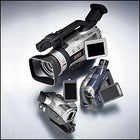 From top: Canon GL2, Sony DCR-DVD101, Panasonic PV-GS120
From top: Canon GL2, Sony DCR-DVD101, Panasonic PV-GS120Ready to start lensing your first exposé? Don’t plunder the 401(k) account for a cable-TV-caliber camera; just get a CANON GL2. You can’t swap lenses on this two-pound-14-ounce handheld shooter, but you can plug in mikes and lights. The fat, crystal-clear Fluorite lens captured color with filmlike precision, even after sundown. And we easily tracked the black helicopters that circled our town one day with the 20x optical zoom and onboard anti-shake technology—swapping out the Mini DV cassette with one hand while staying on-shot with the other. $2,799; 800-652-2666,
Videographers hucked with joy when the first direct-to-DVD cams debuted in 2002—until they discovered that they had to plug the units into a wall socket and wait at least 20 minutes to burn their sick footy onto disc. The SONY DCR-DVD101 slashes that time to eight minutes and will do the job while you stand in line at Starbucks, so you can TV-replay your buddy’s face plant in the powder as soon as you get home. No cables, no computer, no fussing over formats—just a push of a button preserves that spectacular yard sale for generations to come. $899; 877-865-7669,
Ideal for wildlife surveillance, the PANASONIC PV-GS120 packs broadcast-studio-resolution tech into a 19-ounce one-hander. Outback auteurs will get footage so crisp on the Mini DV, they’ll see every hair on Simba’s hide. The trick? It’s a “three-chip” camera—instead of one silicon wafer encoding the image, a trio of them individually capture red, green, and blue. You can get this capability, known as 3CCD, in other units—like the Canon, above—but you won’t find a tidier package at a more titillating price. $695; 800-272-7033,


